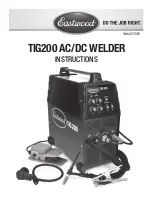
4
FUMES & WELDING GASES CAN BE A HEALTH HAZARD!
• Fumes and gasses released during welding are hazardous. Do not breathe fumes that are produced by the welding operation.
Wear an OSHA-approved respirator when welding.
• Always work in a properly ventilated area.
• Never weld coated materials including but not limited to: cadmium plated, galvanized, lead based paints.
BUILDUP OF GAS CAN INJURE OR KILL!
• Shut off shielding gas supply when not in use.
• Ensure adequate ventilation. Do not weld in confined spaces.
• Always turn your face away from valve outlet when opening cylinder valve.
CYLINDERS CAN EXPLODE IF DAMAGED!
Shielding gas cylinders contain gas under high pressure. If damaged, a cylinder can explode. As gas cylinders are a normal component of the
welding process, use extra care to handle them carefully.
• Protect compressed gas cylinders from excessive heat, mechanical shocks, physical damage, slag, open flames, sparks and arcs.
Keep away from any welding or other electrical circuits.
• Install cylinders in an upright position by securing to a specifically designed rack, cart or stationary support to prevent falling or
tipping over.
• Never weld on a pressurized cylinder or explosion will occur.
• Use only correct shielding gas cylinders, regulators, hoses and fittings designed for the specific application; maintain them and all
related components in good condition.
• Keep protective cap in place over valve except when cylinder is in use.
• Use proper equipment, procedures and have adequate help when moving or lifting cylinders.
HOT METAL & TOOLS WILL BURN!
• Electric welding heats metal and tools to temperatures that will cause severe burns!
• Use protective, heat resistant gloves and clothing when using Eastwood or any other welding equipment. Never touch welded work
surface, torch tip or nozzle until they have completely cooled.
ARC RAYS CAN BURN!
• Arc rays produce intense ultraviolet radiation which can burn exposed skin and cause eye damage. Use a shield with the proper filter
(a minimum of #11) to protect your eyes from sparks and the rays of the arc when welding or when observing open arc welding
(see ANSI Z49.1 and Z87.1 for safety standards).
• Use suitable clothing made from durable flame-resistant material to protect your skin.
• If other persons or pets are in the area of welding, use welding screens to protect bystanders from sparks and arc rays.
FLYING METAL CHIPS CAN CAUSE INJURY!
• Grinding and sanding will eject metal chips, dust, debris and sparks at high velocity. To prevent eye injury wear approved
safety glasses.
• Wear an OSHA-approved respirator when grinding or sanding.
• Read all manuals included with specific grinders, sanders or other power tools used before and after the welding process. Be aware of
all power tool safety warnings.
SAFETY INFORMATION
















